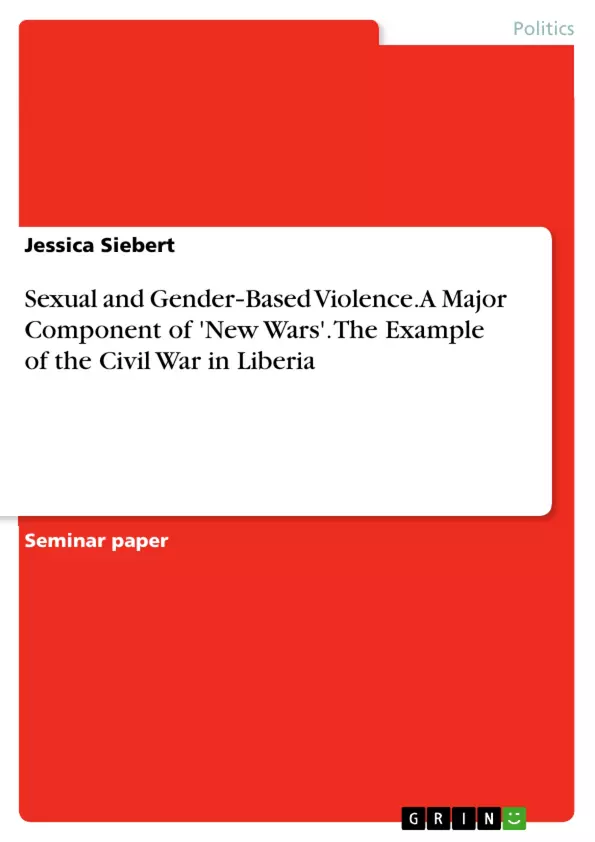For the last few decades, wars all over the world have not been the same as they used to be. Their appearance has changed fundamentally, and thus it seems inaccurate to call them just the same as wars as we know them. ‘Old Wars’ until the beginning of the 20th century were what we would perceive as the ‘classic’ type of war, with two states fighting against each other on a military level. They are, what Clausewitz called „a continuation of political commerce, a carrying out of the same by other means“. Those disputes usually ended after a huge, final battle, which ultimately led to a political decision of some sort. Today, this type of warfare is almost non-existent anymore when it comes to conflicts all over the world. So, what do we call these wars? Kaldor and later Münkler both suggested the term ‘New Wars’ as the most fitting for what we see on a global scale today. But what are these ‘New Wars’, what makes them so significantly different? This question will be answered in this essay, with a specific focus on sexual and gender-based violence (SGBV) and especially on violence against women as one of the most important and shocking factors of those new types of conflicts. It will be highlighted on the example of the African state Liberia, which has recently found its way out of conflict, but is still struggling with the consequences and results of the civil war that has eroded the country with all its institutions and even more importantly, its society. Can this conflict be classified as a ‘New War’ when considering the dimension of SGBV? And how far has the state come in terms of gender equality and the fight against SGBV since the end of the 15-year period of civil war that has impacted the country on so many levels?
Inhaltsverzeichnis (Table of Contents)
- NEW WARS
- WHAT ARE NEW WARS MADE OF?
- SEXUAL VIOLENCE AS A MAJOR COMPONENT OF NEW WARS
- WHAT IS SEXUAL AND GENDER BASED VIOLENCE?
- WHY SGBV IS IMPORTANT FOR NEW WARS
- THE CASE OF LIBERIA
- A SHORT CONFLICT OVERVIEW
- SGBV IN LIBERIA
- FINDINGS
- WAS THE CONFLICT IN LIBERIA A NEW WAR?
- HOW FAR HAVE WE COME? WHERE DO WE GO?
- FURTHER DISCUSSIONS
- CONCLUSION
Zielsetzung und Themenschwerpunkte (Objectives and Key Themes)
This essay examines the defining characteristics of "New Wars" and explores the role of sexual and gender-based violence (SGBV) within them, particularly against women. It uses the example of the Liberian civil war to analyze the impact of SGBV and its relevance in classifying the conflict as a "New War."
- The changing nature of warfare, specifically the emergence of "New Wars."
- The role of identity, ethnicity, and religion in fueling conflicts.
- The pervasiveness of SGBV in "New Wars" and its impact on civilians.
- The significance of gendered power dynamics within conflict zones.
- The consequences of SGBV for individuals and societies.
Zusammenfassung der Kapitel (Chapter Summaries)
The first chapter introduces the concept of "New Wars" and differentiates them from "Old Wars," highlighting their unique characteristics and the evolution of warfare in the 20th and 21st centuries. It presents various definitions and interpretations from prominent scholars, including Mary Kaldor and Herfried Münkler, emphasizing the shifting dynamics of conflict, the rise of non-state actors, and the blurring lines between warfare, organized crime, and human rights violations.
The second chapter delves deeper into the characteristics of "New Wars," examining the role of identity politics, the emergence of new financial sources, and the distinct tactics and means employed. It specifically highlights the increased targeting of civilians in contemporary conflicts and the significance of SGBV as a means of psychological warfare.
The third chapter focuses on the prevalence and implications of SGBV in "New Wars," underscoring its impact on women as primary victims. It explores the historical context of SGBV during conflicts, while also examining the heightened intensity and widespread use of SGBV in recent wars. It also touches upon the complexities of gendered power dynamics within war zones.
Schlüsselwörter (Keywords)
The essay revolves around key concepts including "New Wars," "sexual and gender-based violence" (SGBV), "women in conflict," "civil war," "Liberia," "identity politics," "psychological warfare," "gendered power dynamics," "post-conflict reconstruction," and "human rights violations." It explores the nexus of these concepts and their interrelationship in the context of contemporary conflicts.
- Quote paper
- Jessica Siebert (Author), 2018, Sexual and Gender‐Based Violence. A Major Component of 'New Wars'. The Example of the Civil War in Liberia, Munich, GRIN Verlag, https://www.grin.com/document/1032857



